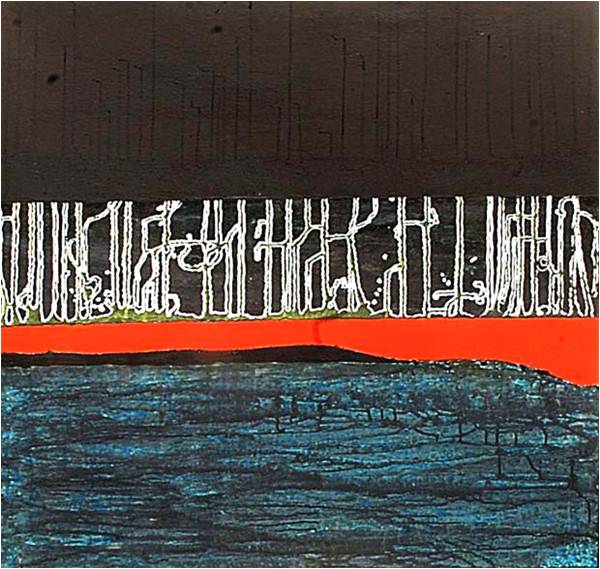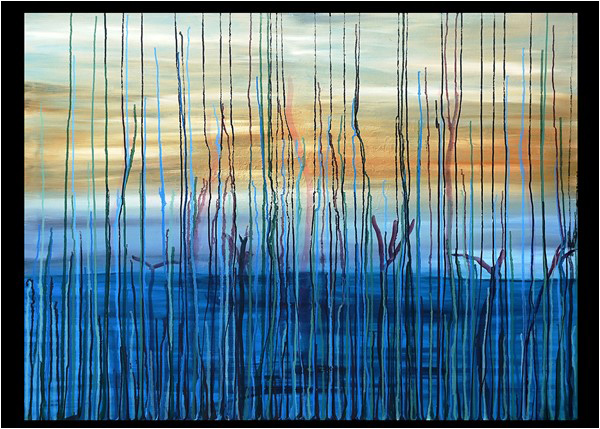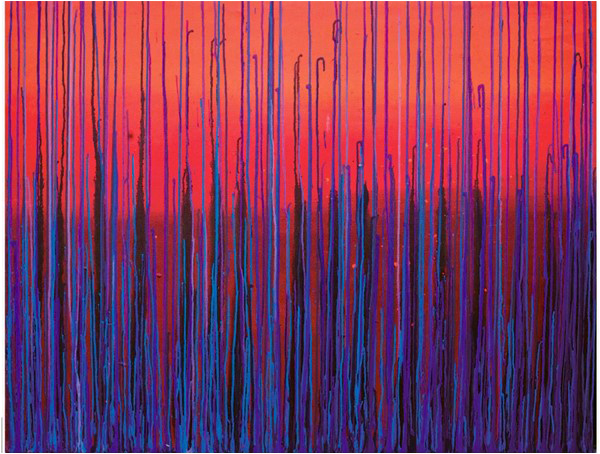
Be thou the rainbow in the storms of life
The evening beam that smiles the clouds away
And tints tomorrow with prophetic ray
Lord Byron could have written these lines for Soraya Sikander, recently invited to exhibit one of her colourful works at the Beijing Biennale, and acclaimed widely for a new style of execution that introduces elements of calligraphy into landscape painting, producing astounding works of contemporary art. Though she graduated in the liberal arts from Beaconhouse National University in 2008, she took up painting and sculpture, and it is in the former that she has made her name. Her art training has been at UCL’s Slade Summer School in 2012, and in Old Masters’ style drawing at the London Atelier of Representational Arts in 2014.
Besides the huge event in Beijing, amongst her many group and solo shows, her works have been displayed in the Netherlands, UK, Dubai, Bangladesh and Karachi, Pakistan. And everywhere one reads that she is “one of today’s leading contemporary South Asian painters.” Recognition for her work has come through critical acclaim and through extraordinary popularity with the international public, making her one of today’s most sought-after artists.

It was the piece titled “Breaking Dawn”, which was exhibited in the Netherlands and was part of her major exhibition, “In, At, Around” at Karachi’s Unicorn Gallery that gave birth to her calligraphic landscapes. This piece, which is certainly remarkable, shows her interpretation of the Karachi sea, while the mangroves reminded her of Arabic calligraphic alphabets. There is a gentle contrast between the variegated sky, changing to blue near the horizon, and the sea itself, with its peaceful movement. A stronger contrast is offered by the slender, vertical black forms of the mangroves in the foreground, as opposed to the horizontal lines of the sea and sky, though they do not detract from the lyrical mood of the painting. To take another example from that show, “Black Landscape” clearly shows the slim, elongated forms of trees, inspired by Karachi’s mangroves. She developed the idea further, pushing the boundaries of landscape painting and ultimately coming up with something entirely new, which was noticed by the international art world and the Western media.
“How did you feel as ‘Breaking Dawn’ developed from your palette?” I asked, and she replied, “The piece was a breakthrough, and created a new genre, dubbed calligraphic landscape. It sold instantly, and created quite a buzz in the art world.” Earlier she had said, “My work has the capacity to surprise me.”
"The way mangroves emerge from the water, their shoots, roots, slim and silhouette-like forms - that is how the whole calligraphic landscape began for me"
Soraya’s ‘Sunset,’ which was displayed at the Beijing Biennale, is somewhat similar in style. However, here the artist has made skillful use of blue paint drips against a brilliant orange sky, fading as it nears the sea. Some of the comments heard in Beijing on this remarkable piece were that it was original, a breakthrough, a pioneering composition, and that it redefines landscape painting. Meanwhile, conversing with Soraya was most informative, and our conversation continued thus.
NJ: How did you feel when invited to exhibit in Beijing, and what was the atmosphere like over there?
SS: It was an honour to be invited to the biennale, held at the National Art Museum of China. It was a huge affair, occupying all the 5 floors of the museum. I was the first Pakistani artist to participate in this prestigious and important art fair. Over 100 countries were represented, and living masters as well as senior painters and sculptors were present. I met some of today’s most engaging, original, pioneering artists, who create cutting-edge work featured in international museums. Needless to say, I learned a lot from speaking with these people. The fair was attended by leading museum directors, curators, scholars, historians, government officials...
NJ: When did you begin painting, and what were your early subjects?
SS: I started painting professionally in 2009. My first exhibition was a group show titled ‘Recession,’ where I displayed a socio-political piece with figurines. However, my style had changed drastically by 2010, when I made a study of floral forms. I found flowers to be a most complete subject, with light, shade, colour, texture and so on. I also found them to be effective metaphors for social comment, but in a more poetic way, totally opposed to much of the art being produced at that time, which was purely laden with shock value. Meanwhile, landscape is also a complete subject, covering a vast range of styles, subjects, symbolism etc.

NJ: Seeing your portrayal of mangroves, one feels that you have a certain reverence for them. What are your comments here?
SS: Exploring the Karachi mangroves was fascinating. The way they emerge from the water, their shoots, roots, slim and silhouette-like forms – that is how the whole calligraphic landscape began for me. This brought together two unique, historical art forms, which is what I see when I study them.
NJ: Is the representation of nature the greatest source of joy in your work?
SS: Essentially I am exploring nature by pushing the boundaries of landscape painting. I discover new ways to paint a picture, comment on what I see, awaken references and find connections between the landscapes of various places. It is, in a sense, a search for meaning, but also a painter’s direct relationship with a subject that awakens something in them.
NJ: You mention ‘the landscapes of different places,’ and I understand that you’ve lived in many countries, especially in Europe. How does this influence your work?
SS: It has broadened my horizon, and given me plenty of exposure. It helps me each day as I set off to create something new, something that refers to actual places, but with a narration quality, as seen through the mind’s eye.
NJ: Finally, did you ever consider teaching art?
SS: I have not yet taught art actively. However, of late I have started receiving many offers, and given my fine arts background from London, I think I might just be able to introduce a new approach to teaching it – as opposed to how it has traditionally been taught in our country, which is rather prescriptive.
NJ: So you wish, in Byron’s words, to ‘tint tomorrow with prophetic ray?’
SS: (laughs)
Noor Jehan lives in Karachi. She devoted 17 years to classical Kathak, has been writing about books and art for many years and is a student of Tibetan Buddhism

